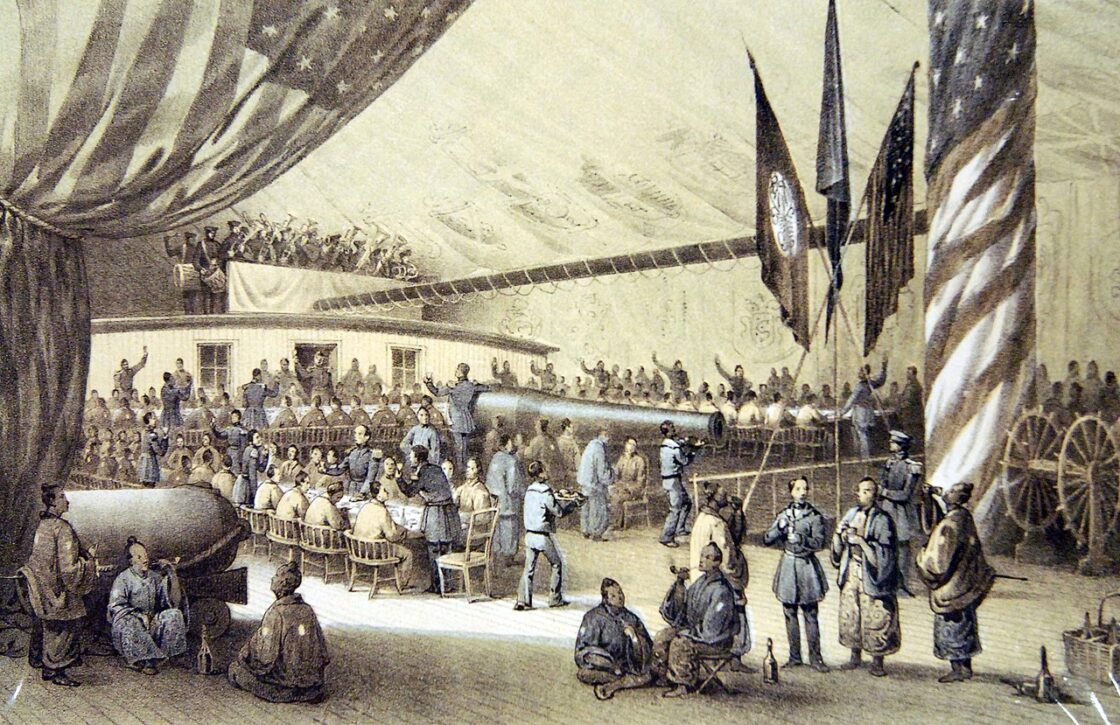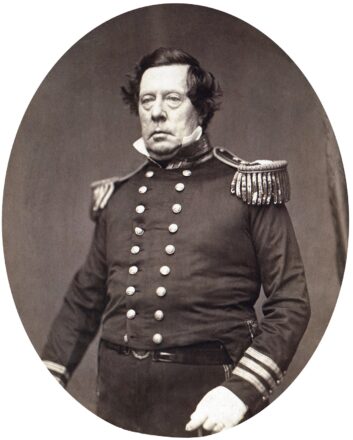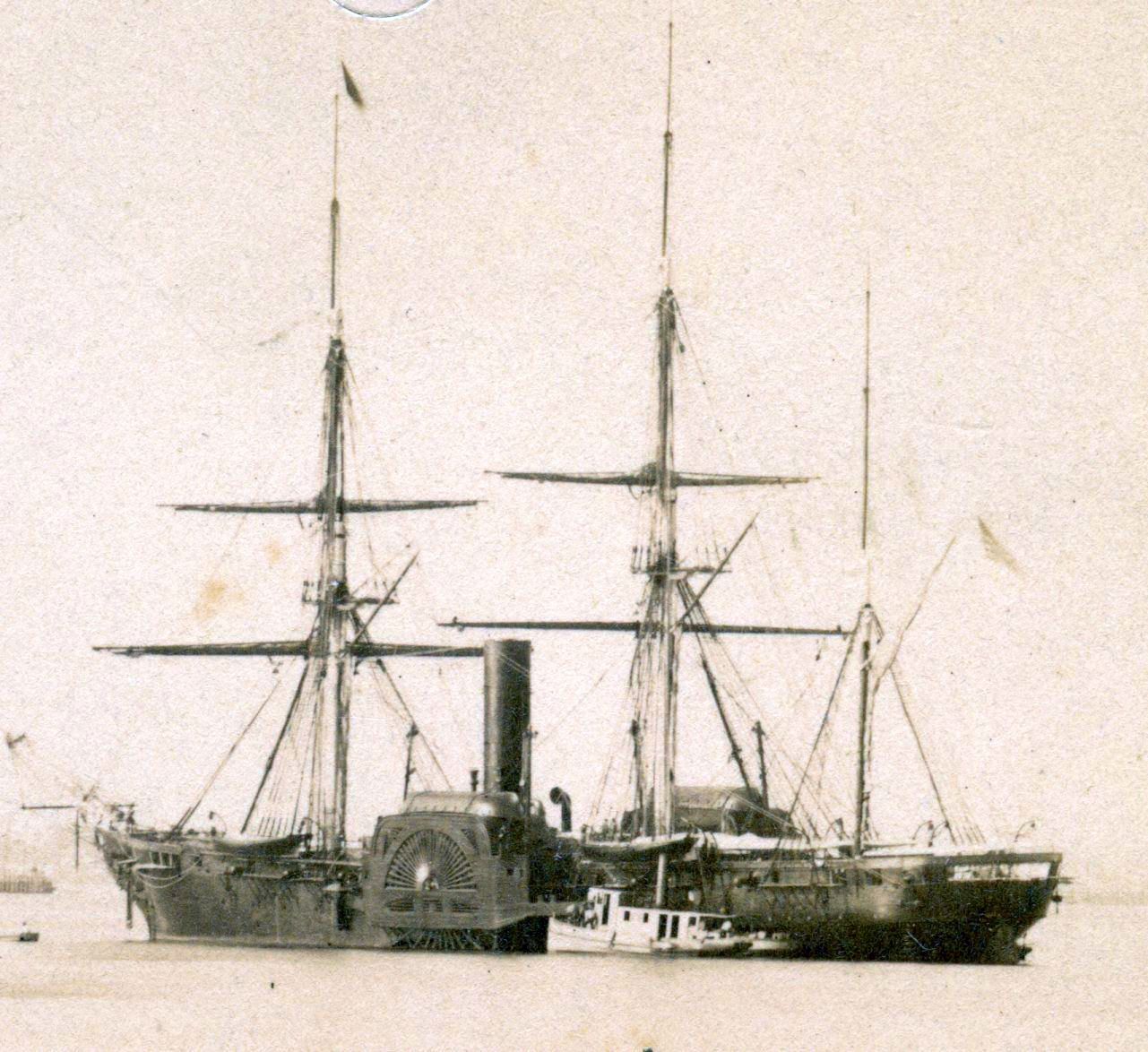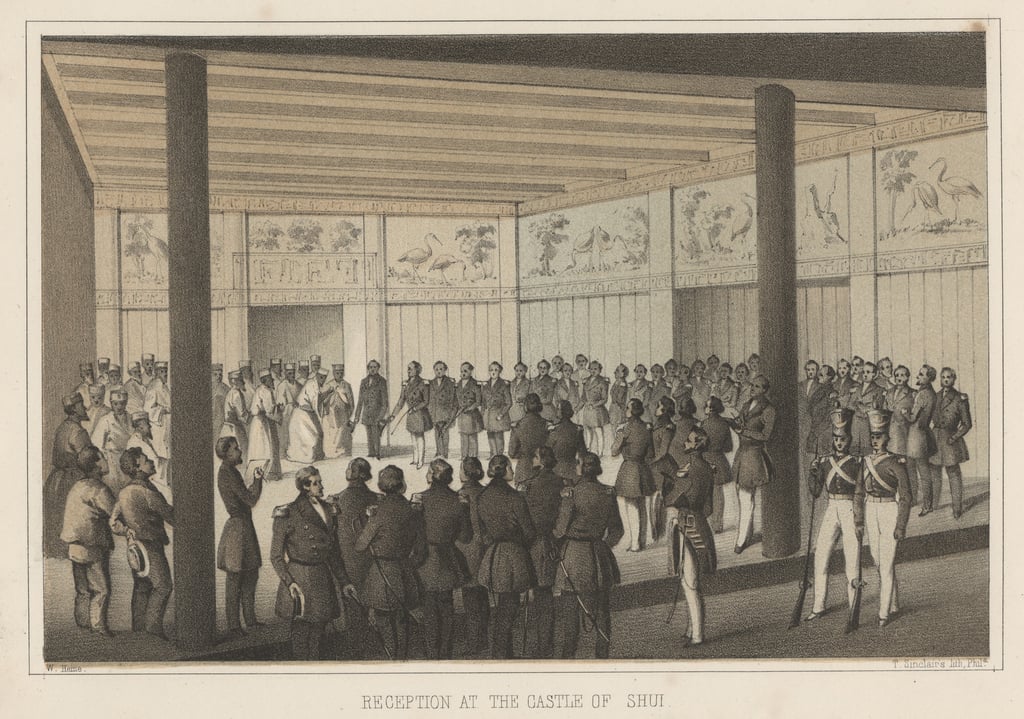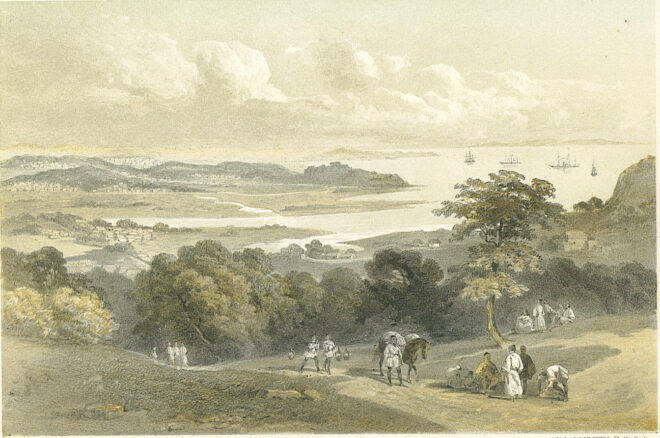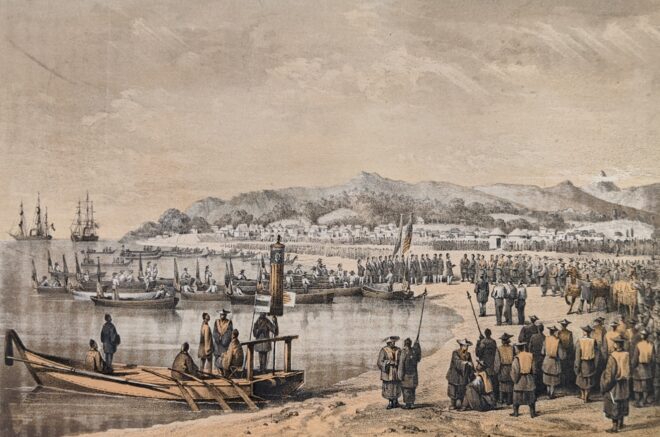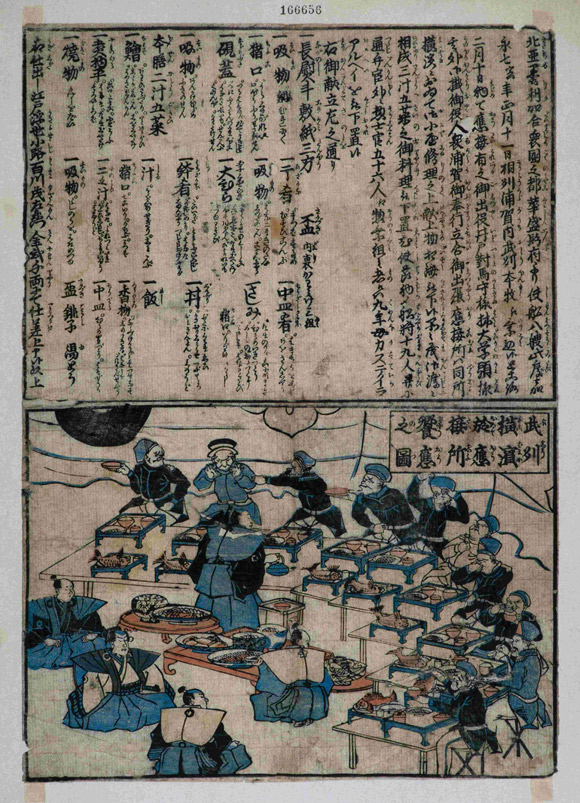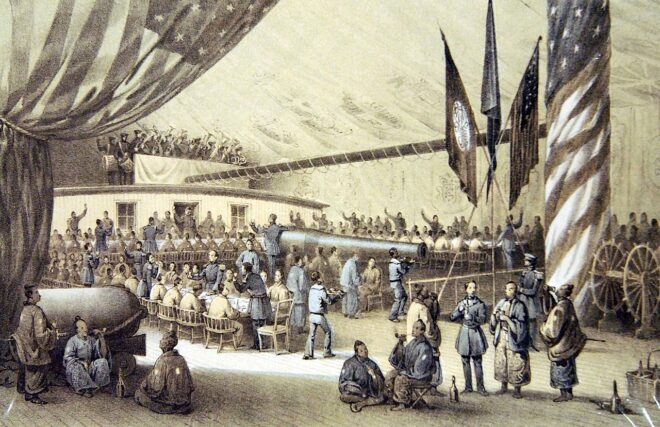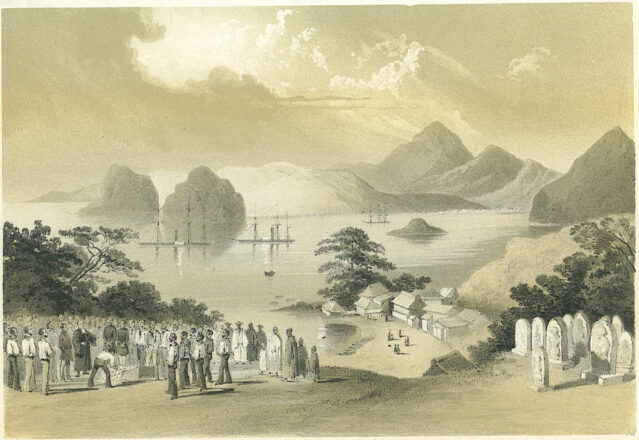2023 marks the 100th anniversary of Japanese whisky. But what set Japan upon that course in the first place? In this timeline-based feature, we take a day-by-day look at the beginning of diplomatic relations between the United States and Japan. It’s a history that involves multi-year international negotiations, strong-arming backed by military might, a good helping of racism/Orientalism, copious amounts of drinking, and even the resulting hangovers.
It’s also the first written record of Japanese people drinking whisk(e)y in Japan*.
Commodore Matthew C. Perry’s fleet of “Black Ships” floated into Uraga Bay, near present-day Yokosuka, Japan, on July 8, 1853. A year later, he returned with even more ships and firepower. But he was still willing to sit at the table. That culminated in the Convention of Kanagawa, signed on March 31, 1854.
Although the Convention’s original aim was solely to open up ports for American ships to resupply and for trade, the historical significance of Perry’s success in Japan can’t be understated. The Kanagawa Convention led Japan down a path of more ports open for international trade, a foreign-born population, modernization, militarization, and eventually, Japan’s own flavor of colonialism in Asia. Despite being in the US Navy, I doubt even Commodore Perry could have predicted how that ended.
Perry’s wasn’t the first attempt at opening Japan. The Portuguese had a thing going in Nagasaki for almost a century until a rebellion was partially blamed on Christianity. The Dutch ran trade through Dejima right up until the signing of the Convention of Kanagawa.
France, the UK, Russia, the Netherlands, and likely other countries all had their eye on opening up Japan. In fact, Perry wasn’t even America’s first attempt — Commodore James Biddle showed up in Uraga Bay with his own black ships in 1846, almost a decade before Perry.
What made Perry successful where others had failed? Was it… whisky diplomacy? I think so, at least partially.
Please note the source material is a timeline collated by the Japan Whisky Research Centre for 2023’s Japanese Whisky Day, specifically for the keynote session entitled “The Dawn of Japanese Whisky.” It has been translated by me and posted here on nomunication.jp with their express permission. That said, I have modified their content a bit, primarily to include quotes directly from the English source material and to give more context for non-Japanese readers.
1794
Apr 10
Matthew Calbraith Perry is born in Newport, Rhode Island as the third son to his US Navy father Christopher Perry and mother Sarah Wallace.
The Whisky Rebellion in Pennsylvania peaks in 1794. The US President at the time was its first, George Washington.
1809
Jan 16
Perry joins the US Navy as an Officer cadet.
1810
Oct 12
He is assigned to the flagship USS President.
In 1810, Russia’s Andre Albanov (sp?) introduces a new method of filtration, using charcoal. This would influence Pyotr Smirnov’s vodka production.
1814
Dec 24
Perry marries Jane Slidell.
1817
Sep 22
He is assigned to the Brooklyn Navy Yard.
1821
Jun 8
Promoted to Lieutenant Commander and becomes commander of the USS Shark.
1825
Apr 6
The Tokugawa Shogunate proclaims Edict to Repel Foreign Vessels and strengthens naval defenses across Japan.
1837
Feb 9
Perry is promoted to Captain.
Mar 15
Relieved of Navy Yard duties.
Tokugawa Ieyoshi becomes the 12th Shogun in 1837.
1840
Mar 2
Perry oversees the production of steamships and the gunnery school. (As commandant of steamship production at the Brooklyn Navy Yard)
The First Opium War breaks out between Qing China and the UK (and lasts until 1842).
1843
Feb 20
Perry becomes the Commander-in-Chief of the African Squadron.
1844
Unknown
Japan receives a diplomatic message from King William II of the Netherlands, urging the country to open.
America signs the Treaty of Wanghia with China in 1844.
1846
Jun 6
French Indochina Commander-in-Chief Rear Admiral Jean-Baptiste Cécille arrives in the Kingdom of Ryukyu to establish trade relations.
Jul 20
Commodore James Biddle arrives in Edo Bay with the USS Columbus and USS Vincennes, looking to open Japan to trade with the United States. He retreats after a mishap involving a samurai guard drawing a sword on him aboard a Japanese vessel. His effort to open Japan was ultimately abandoned.
Aug 20
Perry becomes Captain of the USS Mississippi.
1847
Mar 4
Becomes the Commander-in-Chief of the Gulf of Mexico Squadron.
Revolutions in various European countries in 1848.
1851
Jun 10
President Millard Fillmore orders a Japan Expedition, awarding diplomatic credentials as a special envoy to Japan to John H. Aulick, Commander of the East India Squadron.
Fillmore becomes US President in 1850. He keeps the job until 1853.
Jun
Led by Commander-in-Chief Aulick aboard the USS Susquehanna, the American fleet departs Portsmouth, New Hampshire at the end of June/early July. The USS Susquehanna is accompanied by the USS Saratago and USS Plymouth. The fleet is bound for Guangzhou by rounding the Cape of Good Hope.
America begins the distillation of crude oil around 1850.
Nov
Commander-in-Chief Aulick is relieved of duty.
Prohibition is introduced in Maine in 1851.
1852
Jan 22
Perry receives preparatory orders to assume command of the East India Squadron.
His rank at the time is Commodore.
Mar 24
Assigned to Commander-in-Chief of the East India Squadron by America’s 13th President, Millard Fillmore, and is ordered to the Japan Expedition.
Nov 24
The USS Mississippi leaves Norfolk Naval Shipyard for the Japan Expedition
Dec 17
The fleet arrives in Madeira, Portugal. Receives provisions of drink. This is thought to include a stock of Madeira wine.
Other records put the fleet at Madeira from December 11 to December 15.
1853
Jan 10
Arrival at Jamestown, Saint Helena.
Spent January 10-11 in Saint Helena.
Jan 24
Arrival at Cape Town, South Africa.
Spent January 24-February 3 in Cape Town.
Feb 18
Arrival at Port Louis, Mauritius.
Spent February 18-28 in Mauritius.
Mar 10
Enters port at Point de Galle, Ceylon (present day Galle, Sri Lanka).
Spent March 10-15 in Ceylon. On March 4, 1853, Millard Fillmore resigns as 13th President. He is replaced by Franklin Pierce, who serves until 1857.
Mar 25
Enters port at Singapore.
Spent March 25-29 in Singapore.
Unknown
The USS Powhatan departs America, bound for Japan (will rendezvous for the second Japan visit).
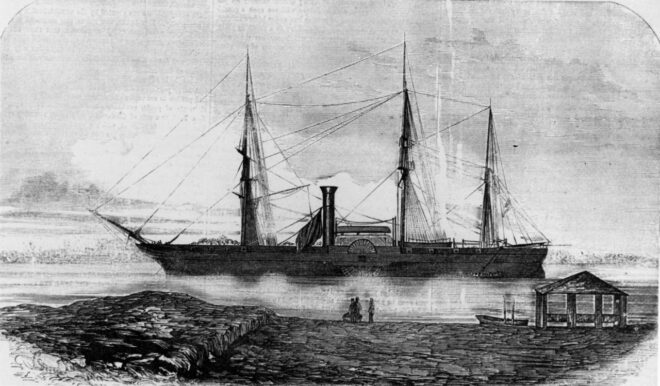
Apr 6
Arrival at Hong Kong by way of Macao.
Apr 7
The USS Mississippi arrives at Hong Kong, and joins the Sloop-of-war USS Saratoga and USS Plymouth, and the stores ship, the USS Supply. These ships join the USS Susquehanna to lead the fleet at Shanghai.
Spent April 7-28 in Macau and Hong Kong.
May 4
Perry’s fleet arrives in Shanghai. They are welcomed as Guests of Honor by Russell & Company during his stay in Shanghai.
May 10
The USS Susquehanna assumes the fleet flagship role.
Sentaro, rescued adrift at sea from the Eirikimaru Disaster, is transferred to the USS Susquehanna. Known to the Americans as “Sam Patch,” he is the only Japanese member of the Perry Expedition.
May 26
The fleet enters port at Naha, Ryukyu Kingdom (present day Okinawa Prefecture, Japan)
Jun 4
A delegation of Ryukyu Kingdom regents visit the Perry fleet (Perry himself does not meet them).
Jun 6
The Perry group goes ashore and visits Shuri Castle. They are later welcomed as guests of advisors to Sho Tai, King of Ryukyu Kingdom. After visiting the Royal Court of the Kingdom of Ryukyu, they are offered local drink (“saki,” today known as awamori) at a reception held by the Consul. “Cups of tea were first handed round ; these were followed by very small cups of saki, which had the taste of French liqueur.” German-American artist Wilhelm Heine, who accompanied the Expedition, noted that they drank “saki, whisky, and punch.” (Heine’s work provides the bulk of American visuals of the Expedition)
Sho Tai himself did not greet his guests. The Ryukyu side opened the gates to the palace, and Perry’s group was lead through the northern part of the grounds.
Perry and his officers were received as honored guests at the minister’s residence, and were offered the finest delicacies. The “saki” from a cup was an especially important gift to the sailors. “When all were seated, the servitors brought in a rapid succession of courses, consisting chiefly of thick soups, or rather stews, in most of which fresh fish was a component part. These were served in small earthen bowls or cups, and were brought in upon lacquered stands, about fourteen inches square and ten high, and placed, one before each guest, upon the tables. Together with each dish was a supply of soy or some other condiment, while throughout there was an abundant quantity, served in peculiar vessels, of the Japanese national liquor, the saki, a sort of whiskey distilled from rice.”
Jun 9
The USS Susquehanna and USS Saratoga depart, bound for the Bonin Islands.
Jun 14
The fleet arrives at Port Lloyd, Peel Island of the Bonin Islands (today’s Futami Port, Chichijima Island, Ogasawara). Perry inspects the island and purchases land for a coal depot.
Spent June 14-18 in Ogasawara.
Jun 28
Perry returns to Ryukyu Kingdom (Okinawa).
Shang Hung Hiun is newly appointed Regent. He and the treasurer are invited aboard the USS Susquehanna for a dinner party. Drinks were offered at this party, especially liquors from across the world.
“They had given the Commodore some of their saki and he was now resolved to give them a taste of the saki made in all other parts of the world. So there were French and German wines, Scotch and American whiskey, madeira and sherry, and the gin of Holland, winding up with the sweet, smooth, strong maraschino, which decidedly, in their estimation, bore away the palm.”
This is the first mention of Scotch and American whiskey in the Expedition record.
Jul 2
The USS Susquehanna, the USS Mississippi, the USS Saratoga, and the USS Plymouth depart Naha. The USS Supply remains behind.
Jul 8
Perry’s “Black Ships” arrive in Japan (for the first time). The fleet arrives at Uraga, dropping anchor at Kamoi / Torigasaki.
Commodore Perry brings with him grog, Scotch whisky, American whiskey, madeira, sherry, genever, maraschino, Champagne, and cherry cordial.
Jul 9
Eizaemon Kayama, translator/interpreter Tatsunosuke Hori, and Tokujuro Tateishi of the Uraga Magistrate, plus 4-5 others, board the USS Susquehanna. The three magistrates meet with Captain Franklin Buchanan.
Jul 11
The USS Mississippi surveys Tokyo Bay, reaching Shibamura (today’s Kanazawa Ward, Yokohama)
Jul 12
Kayama, Hori, and Tateishi visit the USS Susquehanna. Perry gives the diplomatic memorandum addressed to the Emperor of Japan to Kayama. Kayama leaves temporarily but returns to the vessel with his attendant. Aboard, the group has an informal chat and is warmly welcomed.
This is the first definitive record of a Japanese person actually drinking whisky.
Per the requirements of the diplomatic memorandum, the qualified receivers returned to communicate that they would prepare their credentials. They then got a tour of the ship, and were aboard with drink. The three that drank it were Eizaemon Kayama, translator/interpreter Tatsunosuke Hori, and Tokujuro Tateishi.
Jul 14
Only the steam frigates (USS Susquehanna and USS Mississippi) make a move, and Perry arrives in Kurihama. A formal ceremony is held for delivery of the diplomatic letter from the President of the United States (Millard Fillmore). Receiving the letter on the Japan side are Eizaemon Kayama and Ujiyoshi Toda, Uraga Magistrates.
Heine draws “The landing at Kurihama.” (originally captioned “The landing at Gorohama.”)
It depicts Toda Ujiyoshi, Uraga magistate Hiromichi Ido, Eizaemon Kayama, and translator Tatsunosuke Hori.
Jul 16
Kayama and his interpreters boarded the USS Susquehanna to say their tearful goodbyes. It seems the drinks, and tears, were free-flowing. “In the afternoon, Yezaimen and his interpreters came on board again … They seemed in very good humor … [and] evidently lingered with pleasure on board the ship, and were loth to say the final good-bye … and it became still more expansive in its bonhomie under the by no means restricted draughts of champagne … His affection towards his American friends was liberally acknowledged, and he confessed such a yearning for them that he declared he would not be able to restrain his tears on their departure.”
Kayama even decided to crack open a roadie immediately after getting off the ship.
“The Japanese officials now prepared to depart, and finally, after expressing in the most courteous terms their thanks for the treatment they had received, and their regret on leaving their American friends, shook all the officers warmly by the hand, and went bowing and smiling over the side of the ship into their boat. No sooner were they seated on their mats, than Yezaimen showed his appreciation of the present of wine by ordering one of the cases to be immediately opened, and taking the first bottle that came, impatiently knocked off its neck, and without more ado commenced imbibing its contents.”
Unfortunately, Kayama was later dismissed from his post for becoming too friendly with the foreigners. The gifts he received, including the wine, were burned on the beach days later.
The gifts included “one box of tea, one map of the United States, one map of America, one box of Champagne (two bottles), one pack of biscuits, two rolls of cotton fabric, and one large bottle of American alcohol.” There is also a record of “a large bottle of whisky with a thin neck, in a box.”
Jul 17
Perry’s fleet leaves Uraga for the Ryukyu Kingdom. The USS Susquehanna hits heavy winds the next day, and several masts, booms, and riggings are damaged. The USS Mississippi loses two rowboats.
Jul 25
The fleet arrives at port in Naha. They rendezvoud with the USS Supply, still anchored there.
July
Four ships, Russia’s Admiral Putyatin’s fleet, arrive in Nagasaki.
12th Shogun Tokugawa Ieyoshi dies in July 1853 at age 61.
July
Lemonade is also said to have first been brought to Japan on Perry’s Black Ships.
The word “ramune” supposedly originated with a mispronunciation of lemonade.
Aug 7
Commodore Perry enters Hong Kong with the USS Susquehanna and USS Mississippi. He later rents an estate in Macao and lives there.
They were to remain in Hong Kong/Macau until January 1854.
Aug 22
On orders of Nicholas I, Emperor of Russia, Putyatin arrives in Nagasaki as Commander-in-Chief of the Far Eastern Fleet, with the Pallada as the flagship of a fleet of four ships.
Being both rejected by the Japanese government and because of war in Crimea, they soon left.
Nov 28
The Russian fleet departs Nagasaki on November 23rd, and arrives in Shanghai.
Due to outbreak of the Crimean War.
Unknown
Construction of the Shinagawa batteries begins to protect Edo (Tokyo) from attack by sea.
On orders of Abe Masahiro of the shogun’s council of elders, Egawa Hidetatsu, governer of Izu/Nirayama, built water-based Western-style batteries.
1854
Jan 14
The Perry fleet departs Hong Kong.
Jan 22
Perry’s fleet arrives in Naha (the flagship is changed to the USS Powhatan).
Some records indicate the flagship was changed to the USS Powhatan after arrival in Edo Bay.
Feb 1
Part of the fleet (USS Macedonian, USS Vandalia, USS Lexington, and USS Southampton) departs Naha for Edo Bay.
The USS Macedonian and USS Vandalia were sloops-of-war. The USS Lexington and USS Southampton were sailing transport vessels (support ships).
Feb 3
Perry visits Shuri Castle.
Feb 7
The remainder of the fleet (the flagship USS Powhatan, USS Susquehanna, and USS Mississippi) departs Naha for Edo Bay.
Feb 11
Perry’s second arrival in Japan. By February 13, seven ships rendezvous near Koshibata (present-day Yokohama), Edo Bay. Two ships later join the fleet, bringing the total to 9.
The sailing transport USS Southampton arrived first, with six other vessels arriving by the 13th. On March 4, the USS Saratoga (coming from Shanghai, a sloop-of-war loaded with a steam engine as a gift for Japan) arrives. On March 19, the USS Supply arrives with additional goods. Because the USS Plymouth remained in Ryukyu, there were a total of nine ships.
Feb 22
Henry A. Adams, Perry’s second in command, goes ashore in Uraga to negotiate a site for receiving the landing party.
Feb 24
The Perry fleet moves towards Kanagawa, and also surveys the area around Haneda.
Feb 25
Commander Adams and Franklin Buchanan inspect the village of Yokohama (the first time non-Japanese ever landed in Yokohama).
Feb 27
The Tokugawa shogunate agrees to use Yokohama as a reception site.
Mar 8
Perry lands in Yokohama. Delegates from both sides have a meeting. The chief delegate on the Japan side is Hayashi Akira (Fukusai).
This scene is depicted in Heine’s large-format lithograph “Second Landing of Americans in Japan,” from the watercolor. Records like the menus for the reception also remain.
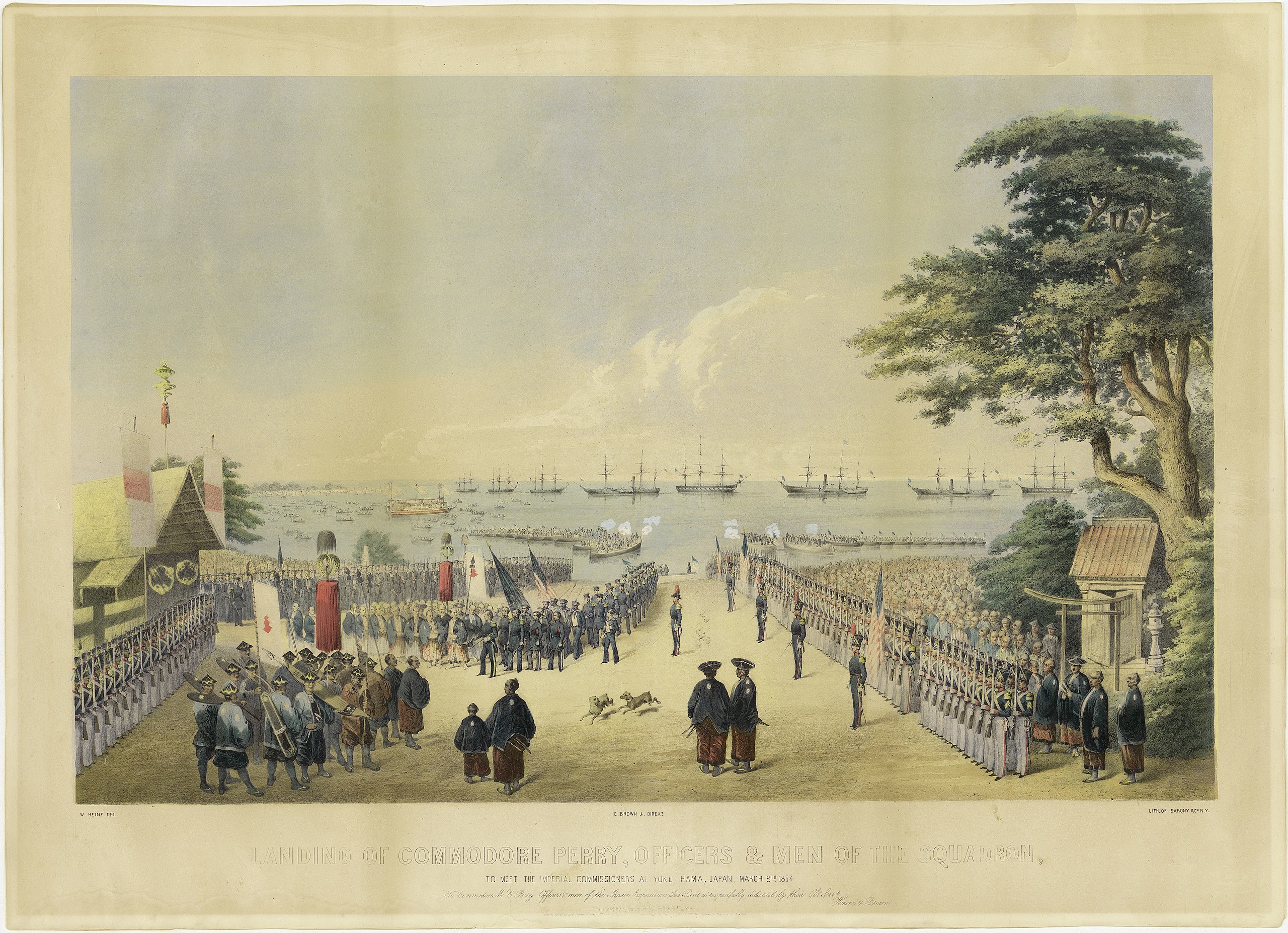
After the meeting, the Japan side (besides Hayashi Akira) hosted a banquet for the Americans. It featured sake, tea, and Madeira wine which was likely acquired through the Dutch. There were 446 attendees between both the American and Japanese sides, and the cost per head is estimated to be around 390,000 yen per person in today’s currency. Two different caterers have been floated: Momokawa in Edo’s Ukiyo district (located between today’s YUITA and Coredo Muromachi buildings) or Yaozen (located in today’s Asakusa/Kita Senju area).
The dinner is depicted in “Image of Reception Dinner at the Guest Room in Musashi Provence, Yokohama.”
Mar 13
Gifts from the American side arrive ashore. These include technology like steam locomotives, but the inventory also shows liquor and casks of whisky.
Mar 14
A list of gifts from the American side is submitted to the shogun’s council of elders. Coastal defense minister Hidetatsu Egawa, the inspector general, inspectors, and others gather to discuss what should be given as gifts in return.
The Americans were told that the gifts could not be accepted because the shogun was not present due to his passing. However, there are no records that indicate the gifts were actually returned. The decision of return gifts for the American side was left to the reception team of Japan, under the condition that they could not give gold or silver.
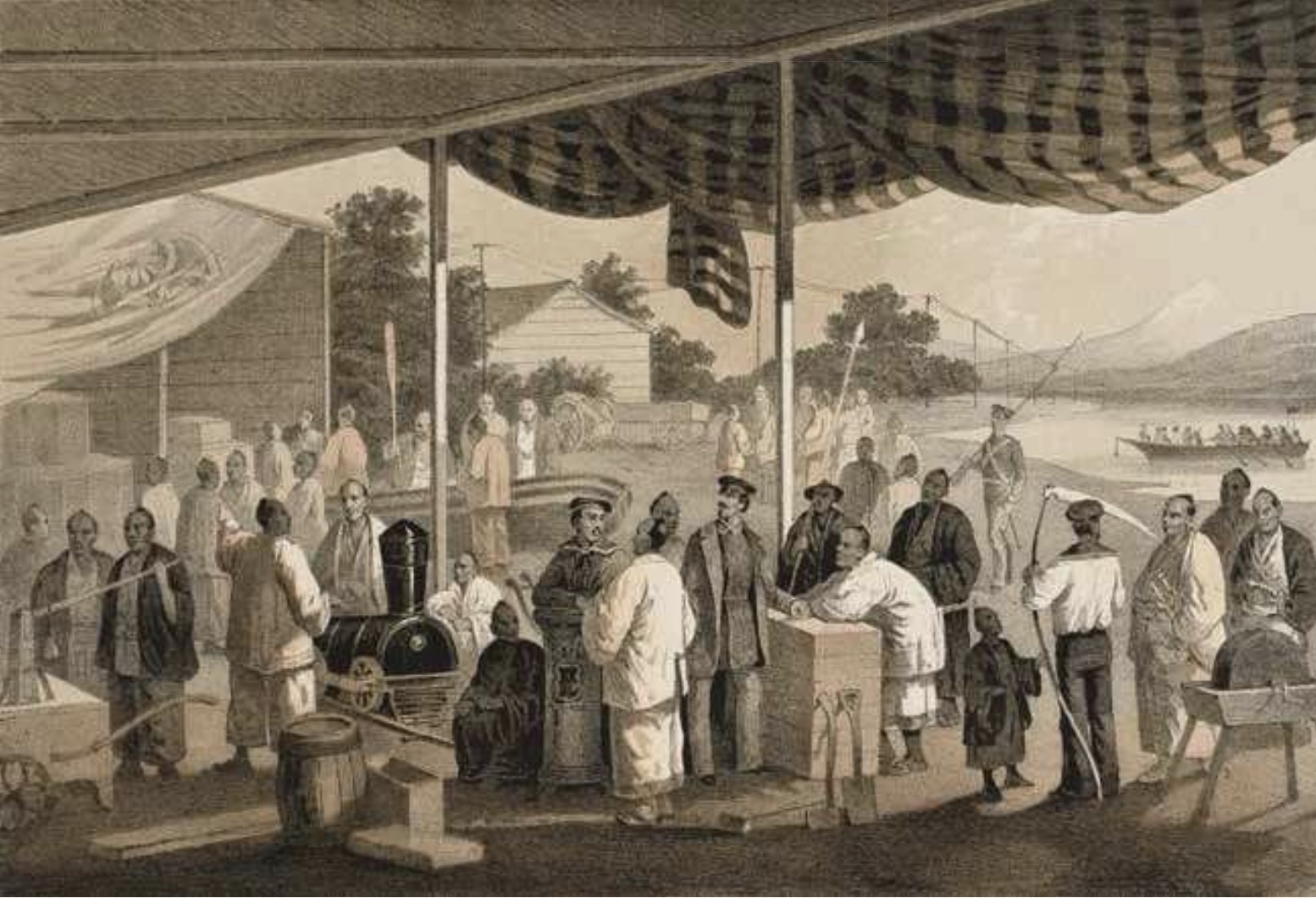
Mar 17
The second round of talks between Japan and America are held.
Mar 21
A model of a locomotive is demonstrated in Yokohama. It is later given as a gift.
Mar 22
Another demonstration is for a morse code telegraph — this is later presented to the government of Japan.
Mar 24
Third round of talks between Japan and America. Japan’s return gifts are delivered to the Americans, and there are also feats of strength and sumo demonstrations by rikishi.
Records of this remain in Akira Hayashi’s “Record of Receiving Black Barbarians.”
Mar 27
Perry holds a reception for Hayashi Akira and other notable comissioners and their attendants from the Japan side. Around 70 people see America’s hospitality on the deck of the USS Powhatan.
Served was wine, liqueur, maraschino, Champagne, madeira, punch, and “John Barleycorn,” thought to be a reference to malt whisky.
“The Japanese party upon deck, who were entertained by a large body of ofiicers from the various ships, became quite uproarious under the influence of overflowing supplies of champagne, Madeira, and punch, which they
seemed greatly to relish … it was, in short, a scene of noisy conviviality, and of very evident enjoyment on the part of the guests.”
Seems it was quite the rager!
“The jovial Matsusaki threw his arms about the Commodore’s neck, crushing, in his tipsy embrace, a pair of new epaulettes, and repeating, in Japanese, with maudlin affection, these words, as interpreted into English : ‘Nippon and America, all the same heart.’ He then went toddling into his boat … “
That rager also included some post-dinner entertainment: a minstrel show, with, unfortunately, blackface.
“After the banquet, the Japanese were entertained by an exhibition of … minstrelsy, got up by some of the sailors, who, blacking their faces and dressing themselves in character, enacted their parts with a humor that would have gained them unbounded applause from a New York audience even at Christy’s.”
Mar 28
The fourth round of talks are held. To nobody’s surprise, plenty of people were hungover.
“[Perry] was met, as usual, at the treaty house by the commissioners, who had more than their ordinary share of gravity, probably owing to the natural effects of the previous day’s conviviality.”
Mar 31
Signing of the Japan-US Treaty of Peace and Amity, also known as the Convention of Kanagawa. This opened the ports of Shimoda and Hakodate, and allowed for American consuls at each port.
The twelve articles of the Convention set Japan upon the path of moving from a closed country to an open one.
Apr 2
The 13th Tokugawa shogun, Ieharu Tokugawa, inspects the gifts from the Americans. Nariaki Tokugawa, daimyo of the Mito Domain, received two Maynard muskets with bayonets. He also borrowed a six-shooter pistol. It’s thought that some of the gifts given to senior shogun and chief vassals included whisky.
Apr 5
Commander Adams departs Yokohama aboard the USS Saratoga, with the new agreement in hand, bound for California.
Apr 14
The Perry fleet visits Shimoda (and stays for 25 days).
Apr
The various ships in the fleet leave for Shimoda in succession between April 14th and 18th.
Apr 25
Shoin Yoshida and others’ plan to visit America aboard the American ships is declined. He would later attempt to stowaway, but was caught by American soldiers.
May 13
Departure for Shimoda, bound for Hakodate.
May 17
The Perry fleet arrives at Hakodate.
May 18
Meeting with Japanese officials.
May 29
Twelve casks of whisky and cherry cordial. Perry holds another reception for Japanese officials aboard the USS Mississippi and USS Macedonian. Japan’s additional gifts include guns, liquor, tea, and perfume.
Jun 3
Departure of Hakodate, bound for Shimoda.
Jun 7
Arrival at Shimoda.
Jun 8
Ashore at Shimoda, the final negotiations between the two parties are held at Ryosenji.
Jun 16
Perry holds another reception for the Japanese officials aboard the USS Mississippi.
Jun 17
Perry receives the “Shimoda Protocol” (with 13 articles) from the Japanese shogunate.
The Shimoda Protocol is a supplementary agreement to the Convention of Kanagawa. It describes the details of opening the ports of Shimoda and Hakodate.
Jun 18
The USS Mississippi becomes the flagship of the fleet at Shimoda.
Other records indicate the date as June 19.
Jun 20
Perry signs detailed clauses of the Convention of Kanagawa.
Also known as the Shimoda Protocol.
Jun 25
The Perry fleet departs Shimoda (per the American official record, the date is the 28th). The USS Powhatan, USS Mississippi, and USS Southampton head for Naha. Along the way, they survey Amami Oshima. The USS Macedonian and USS Supply leave for Taiwan on June 26.
Jul 1
The USS Powhatan and USS Mississippi arrive at Naha. The USS Southampton proceeds directly to Hong Kong.
Jul 11
Perry signs the “Convention between the Lew Chew Islands and the United States of America” with the Ryukyu Kingdom in Naha.
Jul 16
Departure from Naha. Perry, aboard the USS Mississippi, heads for Hong Kong. His interpreter, Samuel Williams, is aboard the USS Powhatan and heads for Ningbo, Fuzhou, Xiamen, then arrives in Guangdong on August 11th.
Jul 22
The Perry fleet arrives in Hong Kong. He is permitted to leave his duties of Commander-in-Chief.
Sep 11
Perry leaves Hong Kong aboard HMS Ganges, a British postal steamer. He is headed back to America by way of Europe.
Sep 29
He changes ships in Ceylon.
Oct 14
James Stirling from the UK, Commander in Chief, China and the East Indies Station, arrives in Nagasaki. He signs the Anglo-Japanese Friendship Treaty.
Oct 17
Perry arrives at the Suez Canal. Because the canal is not yet completed, he must go overland to Cairo and Alexandria.
Oct
From Alexandria, he boards a steamer to cross the Mediterranean, and arrives at Trieste, Italy. From there, he goes to Vienna, Dresden, Berlin, then The Hague.
Nov 20
Arrival at The Hague. He stays with August Belmont, son-in-law of America’s ambassador to The Netherlands, until December 7.
Dec 30
Departure from Liverpool, England, bound for America.
1855
Jan 11
Arrival in New York (Two years and two months after departing America).
Feb 7
Russia’s Putyatin arrives at Shimoda. The Treaty of Shimoda is signed.
This opened the ports of Hakodate, Shimoda, and Nagasaka, agreed on borders, and consul privileges.
Apr 23
The USS Mississippi arrives at the Brooklyn Navy Yard, having crossed the Pacific Ocean and rounding Cape Horn. On it are the journals from Perry’s expedition.
1856
Aug 21
Townsend Harris, the first American ambassador to Japan, arrives in Shimoda.
He is born in New York City to Welsh family.
Sep 21
The Anglo-Japanese Friendship Treaty extends to Nagasaki and Hakodate.
Unknown
The first volume of the “Narrative of the expedition of an American squadron to the China seas and Japan” is published.
1857
Jun 17
Townsend Harris signs the Japan-US Agreement, opening Nagasaki, allowing residents in Shimoda, and establishing a standard for currency exchange.
This finalizes further details of the Convention of Kanagawa. Even moreso than Perry’s 1854 Shimoda Protocol.
Aug 6
Masahiro Abe, chief senior councillor to the shogun, dies (age 39).
Dec 7
Townsend Harris is granted an audience with Ieharu Tokugawa, the shogun.
Dec
“Narrative of the expedition of an American squadron to the China seas and Japan” is completed.
1858
Mar 4
At age 63, Perry dies at home of heart attack due to rheumatic fever that had spread to the heart, in addition to gout and alcoholism.
Mar 6
His funeral is held at St. Mark’s in New York.
Apr 29
Signing of the Treaty of Amity and Commerce, also known as the Japan-US Friendship and Trade Treaty.
Aug 3
The 8th Earl of Elgin, James Bruce, arrives in Nagasaki after signing the Treaty of Tianjin with Qing China.
Aug 26
The “Treaty of peace, friendship and commerce, between Her Majesty and His Majesty the Tycoon of Japan” is signed.
The Earl of Elgin arrives in the waters of Shinagawa on August 12, and signs the agreement with the Edo government.
Oct 9
Signing of the “Treaty of Amity and Commerce between France and Japan.”
Treasy chief/Nagasaki magistrate Tadanori Mizuno, foreign magistrate Nagai Naoyuki et. al and Baron Gros of France sign the agreement.
1859
Jan
Kenneth Mackenzie comes to Nagasaki as the Nagasaki representative for Jardine Matheson.
Jun 26
Sir Rutherford Alcock becomes the first British diplomatic representative in Japan.
He would later pen The Capital of the Tycoon: A Narrative of a Three Years’ Residence in Japan.
Jul 1
The ports of Yokohama, Nagasaki, and Hakodate are now open.
Shoin Yoshida, who attempted to stowaway on the USS Powhatan, and later a contributor to the Meiji Restoration, is put to death at age 30.
1860
Feb 9
Japanese Embassy to the United States goes to America via the USS Powhatan.
1860 is also the year of the Sakuradamon Incident.
Feb 24
The first Western-style hotel in Japan, the Yokohama Hotel, opens.
Japan’s first bar would later be built, called “Macaulay’s Bar.” (Foreigner District #70). It earned its nickname given the head bartender was James B. Macaulay, a Jamaican of British origin.
Jun 26
The Japanese Embassy to the United States visits Perry’s relatives (his wife Jane, daughter Caroline, and grandchild) in New York as a courtesy call.
The visit to the US was also to mutually ratify The Treaty of Amity and Commerce between Japan and the United States.
Unknown
The awamori and shochu brought back from Japan by Perry are presented as gifts to interpreter Gohachiro Namura.
The liquor tax law is revised in 1860. It allows mixing of distillate from different distilleries, leading to a burgeoning industry for blended whisky.
1866
Unknown
Perry is buried in Newport, Rhode Island, at Island Cemetery, in a place now known as Belmont Circle.
14th Shogun Iemochi Tokugawa dies in 1866 at age 21.
*While this is the first written record of whisky being drunk in Japan by Japanese people, it’s likely not the first time a Japanese person ever had whiskey. John Manjiro, one of the first Japanese people to visit the US, lived in Massachusetts in the late 1840s and even trained as a cooper there. He later crossed the US and went back to Japan by way of California, arriving in time to help the shogunate negotiate with Perry.
Sources:
https://visualizingcultures.mit.edu/black_ships_and_samurai/bss_essay04.html
https://nippon.zaidan.info/seikabutsu/2003/00915/contents/0011.htm
http://www.eonet.ne.jp/~shoyu/mametisiki/reference-18a.html
https://manabow.com/zatsugaku/column15/
https://books.google.co.jp/books?redir_esc=y&id=uwALAAAAYAAJ
https://www.city.yokohama.lg.jp/kurashi/kyodo-manabi/library/shiru/sakoku/kaei/kaikoku/picture8/e-177.html
https://en.jpwhisky.net/2022/09/30/whiskeyhistory3-2/#1-3_James_B_Macaulay_the_first_bartender_in_Japan
Hi there! I created and run nomunication.jp. I’ve lived in Tokyo since 2008, and I am a certified Shochu Kikisake-shi/Shochu Sommelier (焼酎唎酒師), Cocktail Professor (カクテル検定1級), and I hold Whisky Kentei Levels 3 and JW (ウイスキー検定3級・JW級). I also sit on the Executive Committees for the Tokyo Whisky & Spirits Competition and Japanese Whisky Day. Click here for more details about me and this site. Kampai!

